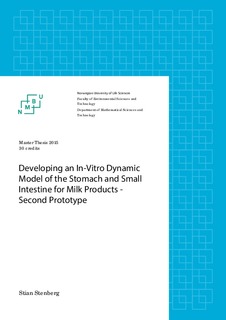| dc.contributor.author | Stenberg, Stian | |
| dc.date.accessioned | 2015-07-30T12:23:29Z | |
| dc.date.available | 2015-07-30T12:23:29Z | |
| dc.date.copyright | 2015 | |
| dc.date.issued | 2015-07-30 | |
| dc.identifier.uri | http://hdl.handle.net/11250/293986 | |
| dc.description.abstract | This thesis is written as part of a project lead by researchers at NMBU who wishes to replicate the physical processes of the digestion system in a human body (in-vivo). To replicate such a system is beneficial for understanding the biochemical-and biomechanical processes in the digestive system.
The aim of this study has been to further develop the first prototype of a dynamic in-vitro (laboratory work) model of the digestive system, considering the stomach and the small intestine.
There are several challenges related to making a dynamic model of the digestive system. For example the imitation of the peristaltic movement in the intestines. The properties of the fluids in the dynamic system need to be the same as for blood and the intestinal fluids. The temperature of the system needs to be the same as for the human body. To keep unwanted organisms out of the system. Choosing and applying a membrane for replicating the intestine and also the practical challenges related to the use of the system.
This thesis has focused on designing parts for solving some of these problems. A “water bath” filled with water keeps a steady temperature of the system and works as foundation for other parts. The “stomach” is replicated by a small glass cup and a “buffer tank” holds the liquid that imitates blood. “Hoses” are used as intestine and leads the fluids in and out of their containers (“stomach” and “buffer tank”). A membrane unit consists of parts for simulating the digestion in the small intestine. Parts for monitoring and stabilizing has also been made or added to the system and ensure a good repetitive system. Finally a user manual for the system is made.
The new prototype can be placed onto a rheometer for viscosity readings, but can also be used without the rheometer which makes it a mobile system. Many parts have been made transparent which ensures good visibility of the physical processes. Problems with membrane attachment, membrane collapse and membrane permeation have been solved or improved. The wish of creating a mathematical model for the diffusion of the membrane has been the reason for doing a lot of permeation tests and two models have been suggested.
For future work the main motivation will be to simulate the digestion of milk mixed with HGJ and HDJ by using the prototype presented in this thesis.
The new prototype is an improvement of the first and ensures a repetitive system as well as estimates to flux can be made. | nb_NO |
| dc.language.iso | eng | nb_NO |
| dc.publisher | Norwegian University of Life Sciences, Ås | |
| dc.title | Developing an in-vitro dynamic model of the stomach and small intestine for milk products : second prototype | nb_NO |
| dc.type | Master thesis | nb_NO |
| dc.subject.nsi | VDP::Technology: 500::Medical technology: 620 | nb_NO |
| dc.source.pagenumber | 124 | nb_NO |
| dc.description.localcode | M-MPP | nb_NO |
